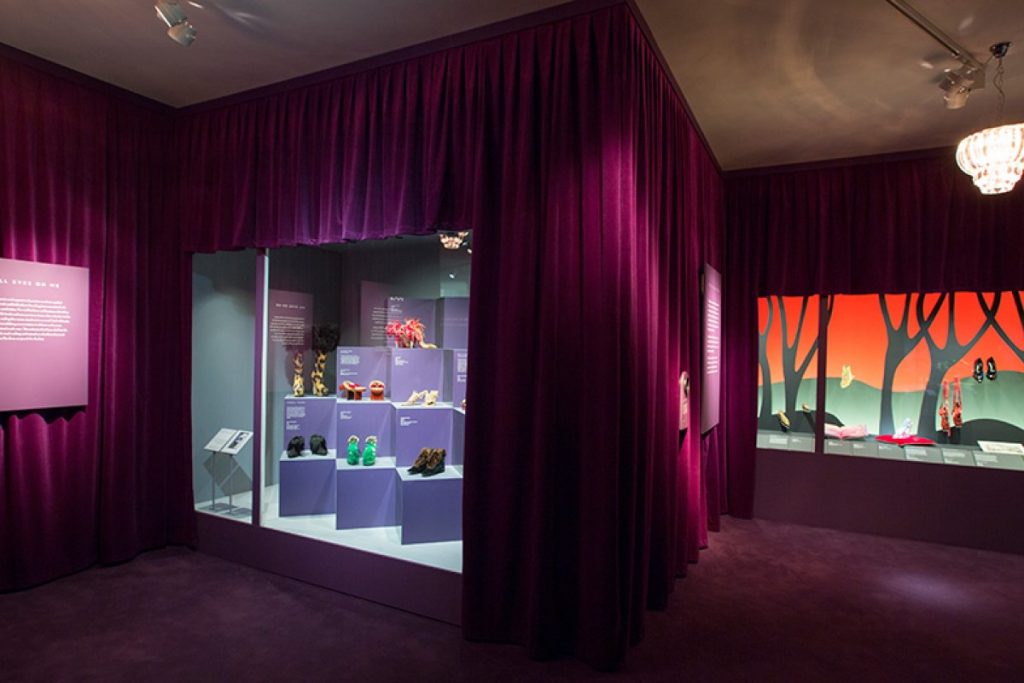Shoes: Pleasure and Pain
The transformative power of extreme footwear is explored in the V&A’s summer 2015 fashion exhibition, Shoes: Pleasure and Pain. More than 250 pairs of historic and contemporary shoes from around the world are on display, many for the first time.
The exhibition explores the agonising aspect of wearing shoes as well as the euphoria and obsession they can inspire. The V&A’s shoe collection is unrivalled, spanning the globe and over 2000 years. For Shoes: Pleasure and Pain, curator Helen Persson has delved into this, other international collections and the wardrobes of private individuals to select an exceptional range of shoes, from a sandal decorated in pure gold leaf originating from ancient Egypt to futuristic looking shoes created using 3D printing.
Shoes worn by or associated with high profile figures including Marilyn Monroe, Queen Victoria, Sarah Jessica Parker, Lady Gaga, Kylie Minogue and the Hon Daphne Guinness are on show as well as famous shoes, such as the ballet slippers designed for Moira Shearer in the 1948 film The Red Shoes. Footwear for men and women by 70 named designers including Manolo Blahnik, Christian Louboutin, Jimmy Choo and Prada are on display. Historic lotus shoes made for bound feet, 16th-century chopines and silk mules with vertiginous platforms designed to lift skirts above the muddy streets also feature.
Exhibition curator, Helen Persson, says: “Shoes are one of the most telling aspects of dress. Beautiful, sculptural objects, they are also powerful indicators of gender, status, identity, taste and even sexual preference. Our choice in shoes can help project an image of who we want to be.”
The exhibition is shown over two floors. The luxurious, boudoir design of the ground floor gallery examines three themes: transformation, status and seduction. ‘Transformation’ presents shoes that are the things of myth and legend, opening with different cultural interpretations of the Cinderella story from across the globe. It explores the concept of shoes being empowering as passed down through folklore, illustrated by the Seven League Boots from the ‘Hop o’ My Thumb’ tale, and how this feeds into contemporary marketing for such things as football boots, and the concept of modern-day, fairy-tale shoemakers, whose designs will magically transform the life of the wearer. ‘Status’ reveals how impractical shoes have been worn to represent privileged and leisurely lifestyles – their design, shape and material can often make them unsuitable for walking – and how shoes also dictate the way in which the wearer moves, how they are seen and even heard.
Shoes on display include Indian men’s shoes with extremely long toes, noisy slap-sole shoes worn in Europe during the 17th century and the now infamous Vivienne Westwood blue platforms worn by Naomi Campbell in 1993. ‘Status’ also demonstrates how historically shoe fashions originated from the European royal courts, while today the focus has shifted to famous shoe designers. Desirable shoes such as the ‘Pompadour’, worn by trend-setting women in the 18th-century French court sit together with designs by the some of the most well-known names in fashion today, including Alexander McQueen and Sophia Webster.
Within ‘Seduction’, the shoes represent an expression of sexual empowerment or a passive source of pleasure. Like feet, shoes can be objects of fetishism. High Japanese geta, extreme heels and tight-laced leather boots are on display as well as examples of erotic styles channelled by mainstream fashion in recent years.
In contrast, the laboratory style setting of the first floor gallery is dedicated to dissecting the processes involved in designing and creating footwear, laying out the story from concept to final shoe. This is enhanced by animations showing how layers are assembled to create finished shoes. The displays show how makers combine traditional craftsmanship with technological innovation and how they unite function with art. Designer sketches, materials, embellishments and shoe lasts, such as the lasts created by H. & M. Rayne for Princess Diana, are on show, alongside ‘pullovers’ from Roger Vivier for Christian Dior. The section highlights the makers’ ingenuity in creating innovative styles and dealing with the structural challenges of creating ever-higher heels and more dramatic shapes.
The exhibition goes on to examine shifts in consumption and production with examples from an 18th-century ‘cheap shoe warehouse’, one-off handmade men’s brogues and trainers made in China. It also looks at the future of shoe design, with experiments of material and shapes, moulding and plastics. On display is footwear that pushes the boundaries of possibility, including the form-pressed ‘Nova’ shoes designed by Zaha Hadid with an unsupported 16cm heel and Andreia Chaves’ ‘Invisible Naked’ shoes that fuse a study of optical illusion with 3D printing and high quality leather making techniques. A film features interviews with five designers and makers: Manolo Blahnik, Sandra Choi, Caroline Groves, Marc Hare and Christian Louboutin.
The last section of the exhibition looks at shoes as commodities and collectibles. Highlights of six different collections are presented: two historic collections, a high end collector, a high street collector, a ‘sneaker head’ and a pair of shoes from Imelda Marcos’ collection.
Images © Victoria & Albert Museum, London
